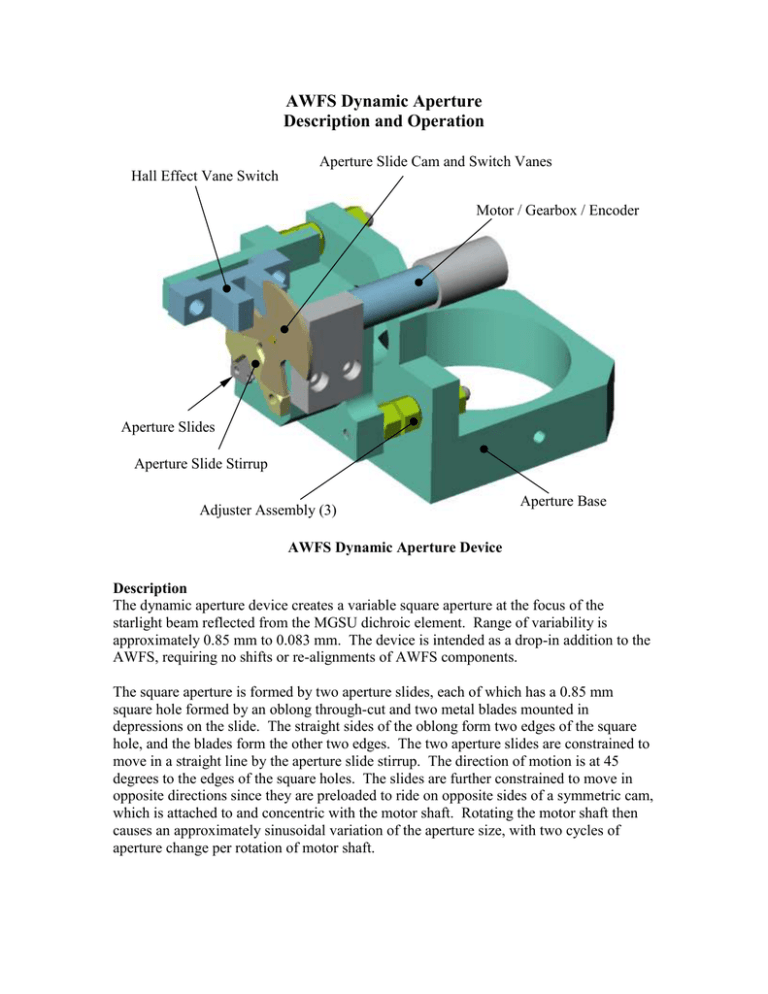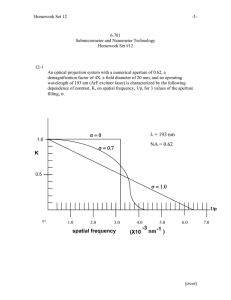AWFS Dynamic Aperture Description and Operation
advertisement

AWFS Dynamic Aperture Description and Operation Aperture Slide Cam and Switch Vanes Hall Effect Vane Switch Motor / Gearbox / Encoder Aperture Slides Aperture Slide Stirrup Adjuster Assembly (3) Aperture Base AWFS Dynamic Aperture Device Description The dynamic aperture device creates a variable square aperture at the focus of the starlight beam reflected from the MGSU dichroic element. Range of variability is approximately 0.85 mm to 0.083 mm. The device is intended as a drop-in addition to the AWFS, requiring no shifts or re-alignments of AWFS components. The square aperture is formed by two aperture slides, each of which has a 0.85 mm square hole formed by an oblong through-cut and two metal blades mounted in depressions on the slide. The straight sides of the oblong form two edges of the square hole, and the blades form the other two edges. The two aperture slides are constrained to move in a straight line by the aperture slide stirrup. The direction of motion is at 45 degrees to the edges of the square holes. The slides are further constrained to move in opposite directions since they are preloaded to ride on opposite sides of a symmetric cam, which is attached to and concentric with the motor shaft. Rotating the motor shaft then causes an approximately sinusoidal variation of the aperture size, with two cycles of aperture change per rotation of motor shaft. The motor has a 10 pulse-per-rev encoder and a 256:1 gearbox, giving 640 pulses across the range of aperture variability. The cam is integral with a vane disc designed to actuate a hall effect switch, thereby providing reference or home points hard-coupled to the rotary motion of the cam, and hence the aperture size. Three cutouts at 90 degrees apart provide switch points for an absolute reference set with no ambiguity. While the switch points are 90 degrees apart, there is no guarantee that switching will occur at the maximum or minimum aperture sizes. There is some adjustability of switch phase relative to aperture phase by sliding the vane switch up or down within the slop of its mounting holes. Installation and Alignment The unit is attached to the mounting post for the first optic in the AWFS. This is accomplished by lowering the base over the first optic until the bore is well engaged with the mounting post, then tightening the two cap screws provided. Coarse alignment is also done at this point by twisting the unit to achieve lateral motion at the aperture, and raising / lowering the unit on the mounting post. Fine alignment is accomplished by differentially moving the three pairs of adjuster nuts on the aperture base. Common mode motion produces piston at the aperture, differential motion side-to-side produces lateral motion, and differential top-to-bottom produces vertical motion. Range of fine adjustment is approximately +/-1 mm. OEM Components of the Assembly Motor – Faulhaber motor from MicroMo: Motor, gearbox, and encoder part number 0816P008SK789+08/1 256:1 +HEM0816P10+X0750E Motor Controller – from MicroMo, part number MVP2001B01 Adapter Cable - from MicroMo, part number MVPCABLE-HE02-12 Hall Effect Vane Switch – Cherry product from Newark, part number 35C0242 (Cherry model VN101503)




